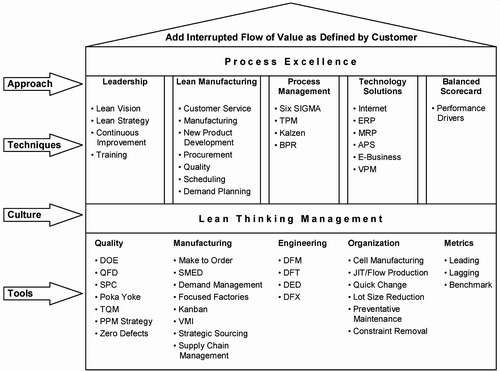Lean Enterprise Part 2
The lean transformation is directed by guiding tenets such as:Positive, clear communications The Lean change effort defines the tools and principles that determine how all aspects of a business operate from sales through distribution. As a result, the right environment for all the competitive elements of quality, design, production, procurement, service and delivery are addressed consistently. Typically, we see benefits to the business like space saving of 50-80%, inventory reductions of up to 90%, reduction of lead-time by 50-75% and quality improvements of up to 300%. In order to be successful, we must follow a rigid-disciplined process. Depending on "low-hanging fruit" opportunities, savings can be realized in several months and have an immediate impact to the bottom line. However, one must be committed for the long run as some change efforts can take as long as 2 years (especially those centered around changing corporate culture).
"Value Stream Mapping" is from the book Learning to See, by James Womak Lean TransformationsThe transformation starts with (1) identifying the need for change, (2) communicating that need for change, (3) defining the "value stream" current and future, (4) identifying those changes which address the need for change and solve the situation at hand (5) developing change plans (6) measuring the results and (7) going back to 1 and starting over.
While there is no fail-safe method for a successful transformation, following a regimented approach is the best advice. When programs do fail, many of the reasons can be traced to a few common themes. Some of these pitfalls of implementing lean are: Not involving the people whom will actually do the work Lean is intolerant of failure, failure of suppliers, processes, people to perform, machines to operate and most important, uninspired leadership. As you streamline the value chain, disruptions to your process will immediately halt your ability to meet customer demands. While this is not desirous, it does allow us to focus in on the issues and solve them, as these islands of lead-time no longer hide them.
|
The goal is to develop a sustained and uninterrupted flow of value to the customer by effectively converting raw materials (or knowledge) to finished goods (or services) across the entire supply chain.
Quality HouseWe believe that Lean Principles can be applied to any environment (high/low volume, high/low mix, job shops, continuous flow and traditional batch facilities) even regulated environments like Pharmaceuticals, Biotech's and Medical Devices. Every system or process contains waste. Every firm (from manufacturing to distribution to service-related) contains activities that add no value to the customer. The tools and techniques used will depend on specific situations and needs. Lean is a holistic approach to reduce waste in the value stream of any process. Like any other paradigm, Lean requires constant attention and commitment, every day of every week of every month of every year. It is a never-ending effort. Toyota went lean over thirty years ago and is still at it.
For question or comments relating to the article or lean tools and techniques, please email authors. VIP is an operations improvement consulting firm specializing in the delivery of value through implementation of Lean Manufacturing and Supply Chain Management tools and techniques in a variety of industries from discrete parts to continuous flow, from distribution to assembly, from aerospace to pharmaceuticals. We have enjoyed equal success deploying these tools and techniques in non-traditional settings like offices, regulated environments and retail settings. Patrick A. Lucansky is President of Value Innovation Partners, Ltd, a Certified Management Consultant through the IMC, teaches operations/ lean courses at the BA/MBA levels Plucansky@vipgroup.us. Remember, techniques get you there, principles keep you there. This article was originally published in the January Issue of PharmaChem Magazine |





